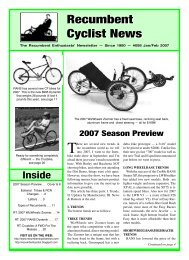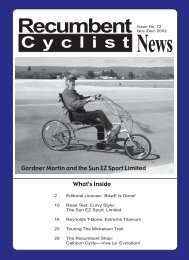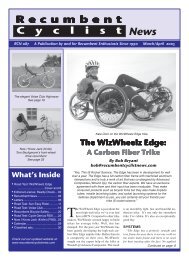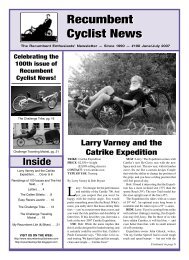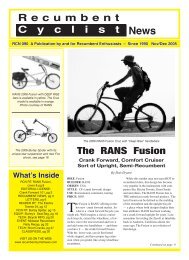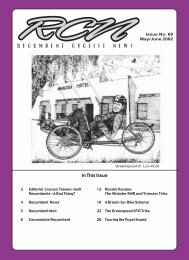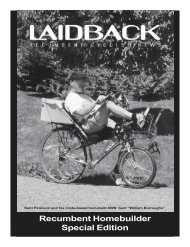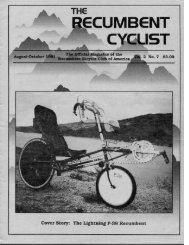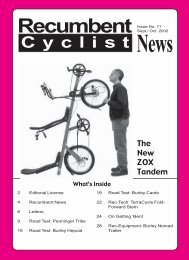What's Inside
What's Inside
What's Inside
You also want an ePaper? Increase the reach of your titles
YUMPU automatically turns print PDFs into web optimized ePapers that Google loves.
their fans.<br />
SRAM 3.0/5.0 are really entry level parts,<br />
however, I rode with them for two months and<br />
had no problems (2006 RANS Stratus LE).<br />
SRAM X.7 is the least an enthusiast should<br />
opt for. While known as a decent entry-level<br />
derailleur, I’ve had them fall apart in my hands<br />
and was not impressed. Just as this article was<br />
about to go to press, I took delivery of another<br />
X.7 equipped bike. The derailleur position set<br />
screw and plastic threads had popped out and<br />
were on the bottom of the shipping box. The<br />
alloy body 2005 model corrected this problem,<br />
but that didn’t hold the pivot bolt and washer<br />
on this new derailleur (c-clip fell out in shipping).<br />
SRAM X.9 From what I hear, the new and<br />
improved X.9 version is better than previous<br />
9.0 models. SRAM X.0 has a forged aluminum<br />
body and offers improved strength and performance,<br />
or so we hear.<br />
Some makers, including RANS, Cycle<br />
Genius and others, are using Microshift front<br />
derailleurs. These seem to work fine, but can’t<br />
be as good as a upper-line Shimano front derailleur.<br />
I would be skeptical of a Microshift<br />
rear derailleur or shifter until they have proven<br />
themselves.<br />
No recumbents come (that we know of) come<br />
with Campagnolo parts. They build mostly<br />
high-end 20/30-speed (10-speed cassette) road<br />
racing components. Unless you know and love<br />
Campy, our recommendation is to stick with<br />
Shimano/SRAM drivetrains unless you are<br />
skilled enough to spec your own bike.<br />
SHIFTERS<br />
SRAM: These twist-grip shifters shift<br />
quickly and are undoubtedly the most popular<br />
shifters for recumbent use. The downside<br />
is that they aren’t as durable, they are louder<br />
(noisy plastic clicks) and when they fail, you<br />
lose your ability to shift. We’ve had three lower<br />
line SRAM shifters, one front and one rear, fail<br />
this year with no advance notice whatsoever.<br />
In my opinion, the ESP 3.0, SR4/5, 5.0 and<br />
perhaps even the MRX are suspect. These parts<br />
work fine out of the box, but they don’t seem<br />
to be designed for serious use. We received a<br />
2006 test bike with new SRAM SR4 shifters.<br />
The front shifter broke on our set-up stand. A<br />
plastic detent that holds the cable in the middle<br />
chainring position broke off inside the shifter.<br />
The SRAM X.9 X.0, Attack and Rocket<br />
models are the best SRAM choice for more<br />
serious enthusiasts. While I’ve had trouble<br />
with the X.7, the new model looks okay and I<br />
never had them break on the road. Frankly, if<br />
ultimate durability was the primary concern, I<br />
just wouldn’t use twist-grip shifters.<br />
SRAM twist grip shifters are notoriously difficult<br />
to twist. A local rider friend of mine had<br />
to remove his left shifter (triple crank shifter)<br />
and replace it with a Shimano bar-end, which<br />
requires much less twisting pressure to shift.<br />
Shimano: Shimano bar-end shifters are<br />
about the best shifters in the world and require<br />
less effort to shift. They are tough and even<br />
have a friction mode (an absolute must for<br />
touring). Paul Components makes an adapter<br />
called the “Thumbie” which converts your barends<br />
to retro style thumbshifters. These can be<br />
expensive AND only work with Shimano rear<br />
derailleurs. Also, bar-ends don’t fit all handlebar<br />
types. Those that don’t fit will probably accept<br />
Paul Thumbies (www.paulcomp.com).<br />
Rivendell: This boutique brand offers retro<br />
friction down-tube and bar-end shifters based<br />
on the old Suntour power ratchet design (little<br />
clicks, non-indexed). If you are tired of 9- and<br />
10- speed indexed shifting headaches, friction<br />
shifting may be the answer. The down-tube<br />
model can be used with the Paul Thumbie<br />
(www.rivbike.com).<br />
Under-Bar Shifters (like Shimano Rapid<br />
Fire): don't work that well on recumbents (especially<br />
OSS) due to knee clearance issues.<br />
CASSETTES<br />
Shimano and SRAM are the industry<br />
standards and offer high-quality shifting performance.<br />
Sunrace is used solely as a cost-cutting<br />
measure. Most recumbents use wide-range<br />
mountain bike cassettes from Shimano and<br />
SRAM in 8- or 9-speed. 8- tends to be spec'ed<br />
on entry level bikes, and 9- on more enthusiast<br />
level bikes. The most popular size is the 11-32,<br />
however, an 11-34 is available and will give you<br />
even lower gearing.<br />
MID-DRIVES<br />
These are midship-mounted gear changers<br />
that require a two-chain drive system. There<br />
are a few different types:<br />
Rear derailleur: This is a two-chain drive<br />
system that can offer up to 72 speeds. It adds<br />
complexity and may take extra time to get accustomed<br />
to. Examples: Rotator, Penninger and<br />
Lightfoot.<br />
Front derailleur: This type shifts a midshipmounted<br />
crankset (with no crank arms) or a<br />
custom cassette with several cogs. The crankset<br />
type is more common. Examples: Cannondale,<br />
Rotator and Longbikes.<br />
These systems are probably unnecessary<br />
for the casual cyclist. Don't buy the argument<br />
that the shorter chains/two-chain drive system<br />
improves anything. If you are just a gear-head,<br />
there is really nothing wrong with them. Sometimes<br />
mid-drives serve a purpose for unique<br />
drivetrains, like those found on the Penninger<br />
and Lightfoot trikes. Just be sure to stock some<br />
replacement parts. When Trek stopped making<br />
its mid-drive recumbent, owners were stuck<br />
with no parts for this proprietary system.<br />
INTERNAL GEARS<br />
Schlumpf: This is a two-speed gear inside<br />
the bottom bracket that is shifted by a heel<br />
button (where the BB dust cap should be) and<br />
- 22 -<br />
doubles the number of gears on your bike.<br />
There are three varieties: the Mountain Drive<br />
is a reduction gear that reduces gears by a factor<br />
of 2.5; the Speed Drive is an over-drive that<br />
multiplies gears by a factor of 1.65; and the<br />
High Speed Drive multiplies gears by a factor<br />
of 2.5. These are ideal for small drive-wheel<br />
bikes or for those who want a simple drivetrain<br />
but a wide range of gears.<br />
SRAM DualDrive: This is a three-speed<br />
internal hub mated to a seven-, eight- or ninespeed<br />
cassette offering 21, 24 or 27 gears at the<br />
rear wheel. The #1 gear is a 27% reduction, #2<br />
is a 1:1 lockup, and #3 is a 136% over-drive.<br />
These work especially well with small drive<br />
wheels or where a very wide gear range is<br />
necessary. On recumbents the Dual Drive is<br />
often used in conjunction with a front crankset,<br />
producing an 81-speed bike (27 gears + 3 Dual<br />
Drive ranges)<br />
Rohloff Speedhub: This is an expensive<br />
jewel-like planetary hub transmission that<br />
offers 14 gears that cover the same range as a<br />
27-speed derailleur drivetrain, and provides a<br />
526% increase between the lowest and highest<br />
gear. The downside is the weight, noise in certain<br />
gears and especially the cost (an additional<br />
$1,000 or so).<br />
CHAIN MANAGEMENT/IDLERS<br />
Due to their unique frame configurations, recumbents<br />
often require guides or chain idlers to<br />
route the chain through the frame and to bypass<br />
the front wheel on SWB models. Each idler robs<br />
some power by adding friction, vibration and<br />
noise into the system. Power-side (top chain)<br />
idlers are the worst for adding friction. Idlers<br />
can be modified skateboard wheels, plastic<br />
chain tubes or fancy CNC aluminum cartridgesealed<br />
bearing assemblies. Idlers and chain<br />
tubes will need to be checked every season as<br />
part of standard maintenance. Keeping a spare<br />
set may not be a bad idea. The larger diameter<br />
and after-market idlers should last much longer.<br />
Upgraded longer life idlers are available from<br />
the TerraCycles.<br />
BRAKES<br />
The following types of brakes are found on<br />
most recumbent bicycles:<br />
Dual Pivot road brakes: These modern<br />
brakes look like the side-pull brakes of the<br />
past, but with two pivot points for extra leverage,<br />
they work like a center-pull. These simple<br />
and elegant stoppers are very lightweight and<br />
are found mostly on recumbent road bikes<br />
(highracers). These should be THE choice for<br />
a serious recumbent road bike. If you’ve only<br />
ridden mountain bikes, you’ll find the road calipers<br />
weak. Dual pivots are lightweight, are easy<br />
to mount and adjust, and changing the pads is<br />
simple. The Shimano 105 and Ultegra stop the<br />
best; Tektro and private label brakes are fine,<br />
but certainly not as good as Shimano. Fitting<br />
good pads can increase braking power.



